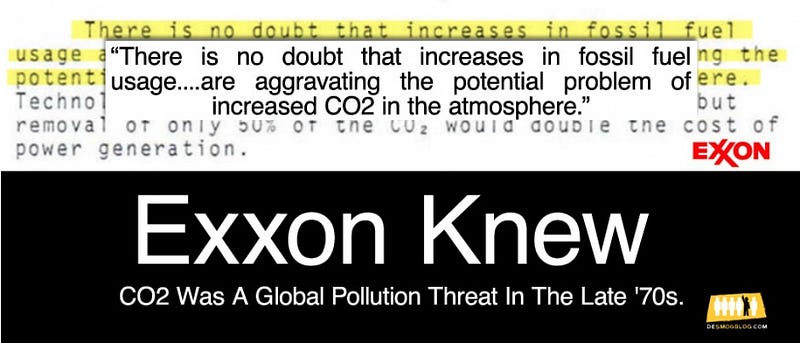Exxon and Chevron have something in common other than oil these days. They both are playing big victims in big ways to distract from their environmental wrongdoing.
These gigantic companies are arguing in court that separate but similar “illegal conspiracies” against them are underway by groups of environmentalists, states attorneys general, trial lawyers and liberal-leaning advocates.
Chevron says it’s being “victimized” by a group of impoverished Ecuadorian indigenous peoples and their lawyers who won a historic $9.5 billion judgment for water and soil contamination in the Ecuador rainforest and want Chevron to pay up now, after 23 years of litigation.

Ecuadorian women and their children living in the rainforest who Chevron says are “conspiring” against the oil giant in collusion with their lawyers and environmental groups, like Amazon Watch — Photo by Lou Dematteis
Note: Chevron demanded the historic court case be tried in Ecuador, in the first place, and accepted jurisdiction there. Three levels of Ecuador’s courts have upheld the damage award, based on no fewer than 106 technical evidentiary reports submitted to the court.
But, like Donald Trump who refuses to accept the outcome of the presidential election unless he wins, Chevron refuses to pay the environmental judgment.That’s after the company stripped its assets from Ecuador during the trial, forcing the Ecuadorians — who have suffered from decades of pollution — to file a lawsuit in Canada to seize company assets there as payment for the Ecuador judgment.
Meanwhile, Exxon would have us believe environmental groups and states attorneys general are colluding — in violation of their 1st, 4th and 15th Amendment rights — by demanding to know what Exxon knew about climate change in the 1970s but intentionally kept from shareholders and the public. They are asking questions about possible securities law violations based on Exxon’s obvious deceptions about global warming. Check out one of numerous internal admissions kept from shareholders.

While Chevron wrote the “victim” playbook, Exxon is taking pages from it. Examples of the eerily similar campaigns:
Similar Message
Exxon spokesman Alan Jeffers used this line in recent news coverage to describe its victimization: “This is a conspiracy to deliberately misrepresent the company’s position and to tear down the company.”
Chevron’s main lawyer Randy Mastro — known for “exonerating” NJ Governor Chris Christie in the Bridgegate scandal — has accused the Ecuadorians and their lawyers of a “criminal conspiracy” and said, if successful, “it will be open season on U.S. corporations.”
Similar Tactics
Chevron has by its own admission sought to demonize one of the Ecuadorians’ lawyers, Steven Donziger. In much the same way, Exxon is demonizing the motivations of state attorneys general.
Exxon has recruited U.S. Congressman Lamar Smith to conduct hearings on the investigation launched by state attorney generals. As Chairman of the House Science Committee, the Texas lawmaker has subpoenaed the environmental groups and Attorneys General in New York and Massachusetts for all sorts of documents as an obvious form of harrassment.
Chevron played a similar card over ten years ago, lobbying Congress to end Ecuador’s trade preferences in retaliation for “allowing” the Ecuadorians to file a lawsuit against the oil giant. Had Congress agreed, Ecuador would have lost thousands of jobs for its low-income residents. A Chevron lobbyist told Newsweek the U.S. “…can’t let little countries screw around with big companies like this — companies that have made big investments around the world.”
Similar Legal Strategy
Chevron countersued the Ecuadorians and their lawyers claiming their entire case was a “sham” and that they were trying to extort money from the company.
In turn, Exxon took the AGs and the environmentalists to court.
Here’s the reality on these two so-called “conspiracies”.
When it became clear the Ecuadorians would win their long court battle in Ecuador, Chevron unveiled an intimidation campaign in the U.S. designed to discredit the Ecuadorians and their lawyers, delay the enforcement of the Ecuador judgment and deceive the public and financial markets about what happened in the South American country.
With over 2,000 lawyers and legal assistants, at least six major public relations firms and as many, if not more, lobbying firms in tow, Chevron filed a retaliatory, RICO lawsuit for extortion and bribery against the Ecuadorians and launched a coast-to-coast PR slander campaign against them and their lawyers.
Now comes Exxon with a similar campaign against 350.org, Sierra Club, the Environmental Defense Fund and the Natural Resources Defense Council and 40 other well-known environmental and social justice groups, as well as the Attorney General.
Exxon’s PR guru Suzanne McCarron told a Business Week reporter that the effort against Exxon “feels very orchestrated” and “we wanted to know who’s behind this thing.”
Of course, it’s no secret — and never has been — who is behind it. All McCarron had to do was Google search “Exxon” and “climate change” and the people criticizing her company will appear. It’s absurd to believe the groups “behind this thing” don’t have constitutional rights to criticize and probe the actions and policies of a publicly-traded company.
But, like Chevron, if Exxon could build a different narrative — one of intrigue, conspiracies, and collusion — then the leaders of the “conspiracy” could be discredited and demonized, just as Chevron tried to do to the lawyers for the Ecuadorian villagers.
“Exxon has hired an army of lawyers to try and distract from the real story here: that they lied about their knowledge of climate change for decades,” said 350.org communications director Jamie Henn. “Delay and deceit.”
“Exxon’s filing leaves out the fact that they have spent millions of dollars funding misinformation campaigns, faux think tanks, and the elections of climate deniers. They’re reacting this way because they know the stakes of this investigation are enormous.”
The Ecuadorians could tell the U.S. environmental groups a thing or two about delay, deceit, and distractions.
Delay: 23 years of litigation in U.S., Ecuadorian and now Canadian courts, thanks to the litigious Chevron and its bottomless pit of money for lawyers.
Another example of Chevron’s deceit and deception in Ecuador rainforest.
Deceit: Chevron’s paying a witness over $2 million in cash and benefits to testify falsely against the Ecuadorians that they bribed a sitting judge and wrote the judgment for him. The $2 million is four times the amount of the false bribery claim. Chevron’s lawyer Mastro and his team spent 53 days “coaching” the witness to lie.
Distractions: Filing lawsuits in dozens of jurisdictions to draw attention away from the pollution in Ecuador and drain the Ecuadorians of any money for lawyers so they are not able to enforce the judgment that three layers of appellate courts in Ecuador have upheld.
Despite the delays, deceit and distractions, the Ecuadorians are still fighting Chevron and could end up collecting the full amount of their judgment in Canada, where the country’s Supreme Court backed them in a unanimous procedural decision in 2015.
Time will tell. Chevron as well as Exxon should look around and see how the world is changing. Time is running out for both climate change deniers and corporate polluters.